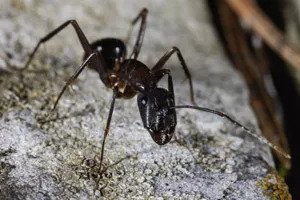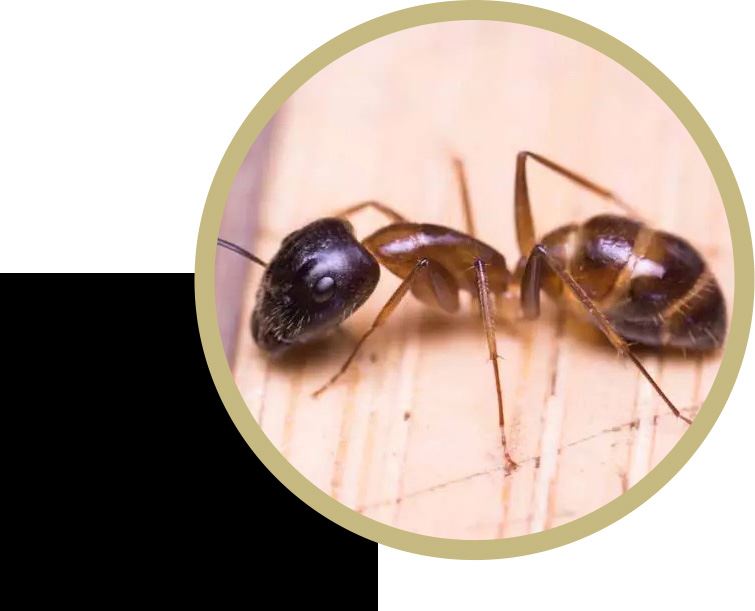 >
>
What Do Carpenter Ants Look Like, and Do They Have Wings?

What Are Carpenter Ants?
Carpenter ants are large ants known for their wood-destroying ability. They reside here in the Pacific Northwest and throughout the world. They commonly inhabit moist or decaying wood including hollow trees, posts, landscaping wood, logs, and wood structures.
Need help getting rid of flying ants? Contact United Pest Solutions for ant control today at (888) 880-3374 or by filling out an online form!
Do Carpenter Ants Have Wings?
Carpenter ants do have wings, but not all of them. Winged carpenter ants are reproductive adults known as swarmers. They appear during mating season, often indicating a nearby nest.
The majority of carpenter ants you encounter in your Bellevue, WA home are wingless worker ants. They are responsible for foraging and building nests, not flying.
Swarmers have not one, but two sets of wings, which sit on their thorax above their waist. The front set of wings is longer than the back set. These guys are also the big shots of the colony - they're larger than their fellow ants.
What's The Difference Between Female and Male Flying Ants?
Now, let's talk about gender differences in flying ants. Male swarmers are teeny tiny compared to their female counterparts, who can grow to be three-quarters of an inch long. And although they look similar to termite swarmers, there are noticeable differences in their wings, body structure, and antennae shape that set them apart.
Once a carpenter ant colony hits the two-year mark, it's time for the queen to produce those alates (aka the swarmers, or flying ants). These are the reproductive ants of the colony whose one job is to mate and form new colonies.
Need help getting rid of these pests? Contact our pest control company for ant control today!
What Do Carpenter Ants Look Like?
The most common feature of a carpenter's ant is its size. Carpenter ants are huge compared to other ants. Queen carpenter ants can range up to 18 millimeters in length while worker carpenter ants range in size between 6 and 13 millimeters long. Carpenter ants also range in color. While most are black, they can also be a combination of red and black.
To identify a flying carpenter ant, you’ll notice it has two sets of wings of unequal length, a thin waist, and bent antennae. Flying carpenter ants are also larger than worker carpenter ants.

Carpenter Ant Habits
As spring arrives, flying ants start their search for the perfect mate. The male carpenter ant will devote himself entirely to this mission - once he's succeeded, his time is up. But for the lucky female, the real adventure is just beginning.
After shedding her wings, she sets off to find the perfect nesting spot for her new colony. And, as it turns out, carpenter ants have a unique taste in real estate - they love rotted or damp wood. Who knew ants could be such connoisseurs of home decor?
Where Do Carpenter Ants Come From?
Most carpenter ants live outdoors in hollow wood where there is a lot of vegetation, but it’s not uncommon to have carpenter ants living around patios, foundations, and other wood structures on your property.
This is because carpenter ants have two nest types: parent colonies where the queen lives and stay due to need humidity levels for her eggs which support the lifecycle and satellite colonies which worker ants use to transport food and care for their pupae. These areas are like incubators for their young and our homes and business make a perfect environment for their survival and thriving of their pupae.
Problems with Carpenter Ants
Carpenter ants are especially problematic, because of their wood-destroying habits. While many people think carpenter ants eat wood like termites, they actually excavate it. They do this to help build their nests. Carpenter ants prefer to eat honeydew, insects, and plant and fruit juices.
Carpenter Ants or Moisture Ants?
Here in the Pacific Northwest, homeowners commonly confuse moisture ants with carpenter ants because moisture ants will also build their nests in moist, rotted, and decaying wood. However, moisture ants are smaller, about 4 to 4.5 millimeters in length, and they’re brown in color.
Also, moisture ants aren’t wood-destructive. They only nest in areas with high moisture, speeding up the process of wood rot and eating fungus and mold in the decayed wood. Furthermore, moisture ant reproductives swarm in the Fall (August/September) while carpenter ants swarm in the Springtime (April/May).
Need to get rid of flying ants? Contact our pest control company at (888) 880-3374 for ant control today!

Our team’s commitment to solving our community’s pest problem is the foundation of our company. With our team, you can say goodbye to unwanted pests for good.
How to Get Rid of Carpenter Ants?
While carpenter ants initially infest wet, decaying wood, they may later begin to excavate through undamaged wood as well.
To help control carpenter ants,
- Remove moist, rotting wood from your property
- Trim back bushes and plants at least a foot away from your home
- Seal cracks in your foundation, around windows, and near plumbing and electrical openings
- If you keep firewood on your property, store it away from your home
Oftentimes carpenter ant infestations go unnoticed until it’s too late and severe damage has been done. If you see flying carpenter ants, this is generally a sign an infestation is nearby. So you’ll want to contact a licensed pest control company, like United Pest Solutions. We’ll locate trails and identify the parent colonies, eliminating your pest problem for good.
Are you having a carpenter ant problem? Our exterminator is ready to help. Contact our pest control company at (888) 880-3374 for ant control today!
Ready to Get Started?
Use the form below or give us a call at (888) 880-3374.








